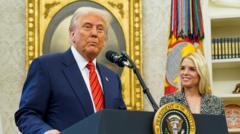The newly signed executive order by President Trump seeks to decrease high prescription drug prices in the US, yet doubts remain regarding its actual effectiveness. Analysts note that negotiations with the pharmaceutical industry and compliance obstacles could hinder substantial changes, as the complexities of the American healthcare system continue to pose challenges.
Trump’s Executive Order Aims to Lower US Drug Prices Amid Skepticism

Trump’s Executive Order Aims to Lower US Drug Prices Amid Skepticism
President Trump’s latest move to tackle overpriced medications in the US raises questions about its potential impact and efficacy, amidst industry backlash.
In a bold attempt to address the persistently high cost of prescription medications in the United States, President Donald Trump has signed an executive order aimed at reducing drug prices for Americans. Highlighting discrepancies between the costs borne by US patients compared to those in other countries, Trump asserts that his order could lead to price reductions of "30% to 80% almost immediately."
However, skepticism surrounds his claims, with experts noting the complexity of the US healthcare system as a significant barrier to achieving those goals. The current system, which includes a mix of private and public insurance schemes, allows for substantial drug price inflation due to a lack of centralized negotiation, a practice seen in many developed nations where governments can reject exorbitant costs.
During a White House briefing, Health Secretary Robert F. Kennedy Jr. emphasized the bipartisan concern over drug pricing, indicating that both major political parties have grappled with this issue. Trump criticized the powerful influence of pharmaceutical lobbying, suggesting that US taxpayers are unwittingly subsidizing healthcare for citizens abroad. He vowed that U.S. practices would no longer promote such inequities.
The executive order suggests that the U.S. could adopt a "Most Favored Nation" (MFN) status, compelling drug manufacturers to align U.S. prices with the lowest rates offered elsewhere. Yet, the specifics of enforcement remain ambiguous; it is unclear how the administration plans to ensure compliance or what sanctions might apply for non-compliance.
Investors reacted cautiously post-announcement, with shares of major pharmaceutical companies initially dipping but recovering quickly, showcasing a lack of confidence in the plan’s immediate effectiveness. Researchers also raised concerns that if companies feel pressured, they may withdraw from international markets or reduce investment in research, potentially stifacing medical innovation.
Further complicating matters, the executive order did not define "unreasonable or discriminatory" pricing practices, leaving paths open for interpretation by drug companies. Experts have warned that while the move could hint at a step toward greater transparency, substantial changes in pricing dynamics remain uncertain.
The healthcare community is predominantly skeptical, with critics arguing that the order could hinder drug availability and compromise funding for vital medical research. Some academics advocate for alternative funding methods for drug development, asserting that research investments precede profit generation.
As public sentiment increasingly favors reform, the effectiveness of Trump’s order in ensuring equitable drug prices remains in the balance. The coming months will reveal whether this bold executive action can transform the landscape of American pharmaceuticals or if it will simply be rhetoric with little follow-through amid ongoing industry resistance.




















